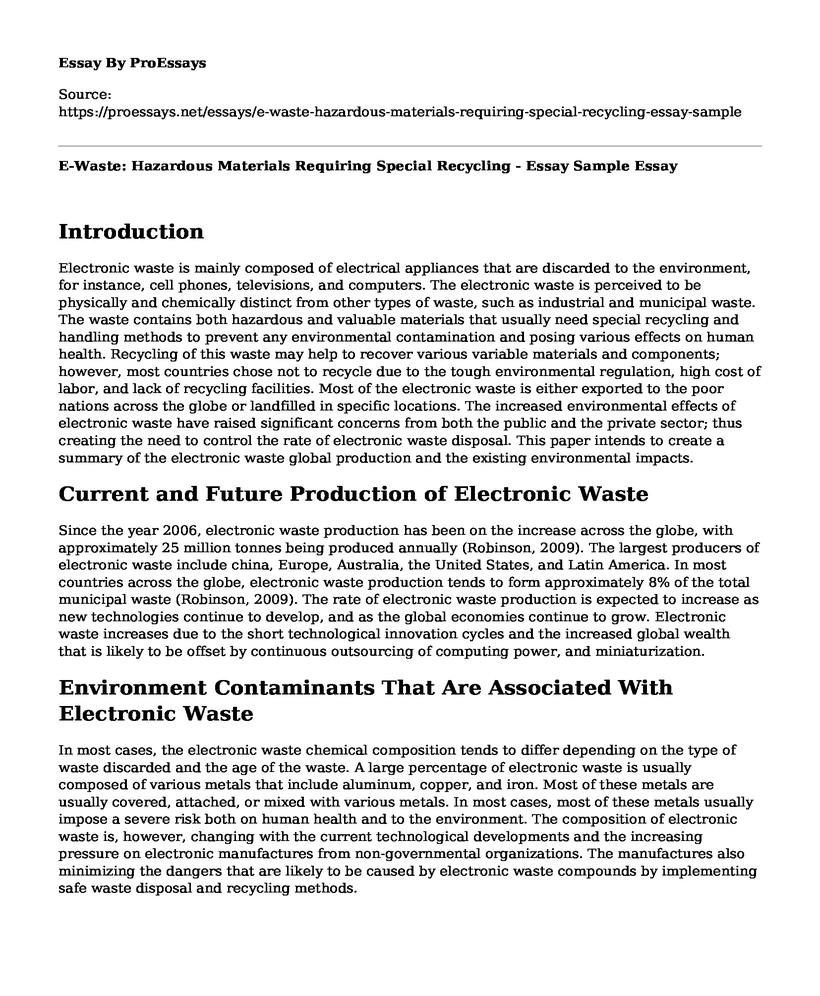Introduction
Electronic waste is mainly composed of electrical appliances that are discarded to the environment, for instance, cell phones, televisions, and computers. The electronic waste is perceived to be physically and chemically distinct from other types of waste, such as industrial and municipal waste. The waste contains both hazardous and valuable materials that usually need special recycling and handling methods to prevent any environmental contamination and posing various effects on human health. Recycling of this waste may help to recover various variable materials and components; however, most countries chose not to recycle due to the tough environmental regulation, high cost of labor, and lack of recycling facilities. Most of the electronic waste is either exported to the poor nations across the globe or landfilled in specific locations. The increased environmental effects of electronic waste have raised significant concerns from both the public and the private sector; thus creating the need to control the rate of electronic waste disposal. This paper intends to create a summary of the electronic waste global production and the existing environmental impacts.
Current and Future Production of Electronic Waste
Since the year 2006, electronic waste production has been on the increase across the globe, with approximately 25 million tonnes being produced annually (Robinson, 2009). The largest producers of electronic waste include china, Europe, Australia, the United States, and Latin America. In most countries across the globe, electronic waste production tends to form approximately 8% of the total municipal waste (Robinson, 2009). The rate of electronic waste production is expected to increase as new technologies continue to develop, and as the global economies continue to grow. Electronic waste increases due to the short technological innovation cycles and the increased global wealth that is likely to be offset by continuous outsourcing of computing power, and miniaturization.
Environment Contaminants That Are Associated With Electronic Waste
In most cases, the electronic waste chemical composition tends to differ depending on the type of waste discarded and the age of the waste. A large percentage of electronic waste is usually composed of various metals that include aluminum, copper, and iron. Most of these metals are usually covered, attached, or mixed with various metals. In most cases, most of these metals usually impose a severe risk both on human health and to the environment. The composition of electronic waste is, however, changing with the current technological developments and the increasing pressure on electronic manufactures from non-governmental organizations. The manufactures also minimizing the dangers that are likely to be caused by electronic waste compounds by implementing safe waste disposal and recycling methods.
Recycling and Disposal of the Electronic Wastes and the Probable Environmental Contamination
Most of the electronic waste that is currently produced across the globe is usually landfilled using the toxicity characteristic leaching procedure. The disposal of this kind of waste in the municipal wasteland fill without using the TCLP is linked to increased lead leachate concentrations that are of high concern. Electronic manufacturers are also recycling electronic waste to reduce contamination. Electronic waste recycling mainly involves the destruction and disassembly of the electronic equipment's with the intention of recovering the new materials. Recycling can recover a large number of useful compounds or materials from electronic products. The variable materials from the electronic products are usually recovered using the pyro-hydro- and bio-metallurgical methods.
The Environments That Are Contaminated By the Electronic Waste
The electronic waste components are likely to affect or pose significant effects on various parts of the ecosystem in different ways. Some of the areas affected by electronic waste include the soil and other terrestrial environments. Soil from an area whereby acid leaching had been used to recover the electronic materials tends to contain high amounts of polycyclic hydrocarbons, which result to the contamination of the entire food chain. Secondly, the aquatic system. The electronic waste contaminants usually pollute the aquatic environment through leaching from the electronic waste dumpsite where both the processed and the unprocessed waste are deposited. Thirdly, airs, in most cases, electronic waste, usually contaminate the air through the dust particles that spread to the atmosphere. The electronic waste also tend to affect human beings when they are exposed to some of the toxic electronic waste contaminates.
Conclusion
The electronic waste is mainly characterized by the challenges of determining its specific mass and the waste's unusual chemical composition. The contaminants that originate from the electronic waste have already caused huge damage to the environment, particularly to the poor nations and also affected the lives of the people living in the regions where the waste is disposed off. However, this contamination risks can be prevented by implementing the standard remedy technologies. In the developed nations, they usually have a specific self-interest in preventing the negative effects of electronic waste since they believe that they will negatively impact the quantity and quality of the manufactured goods and food.
References
Robinson, B. H. (2009). E-waste: An assessment of global production and environmental impacts. Science of the total environment, 408(2), 183-191. Retrieved from http://citeseerx.ist.psu.edu/viewdoc/download?doi=10.1.1.452.1498&rep=rep1&type=pdf
Cite this page
E-Waste: Hazardous Materials Requiring Special Recycling - Essay Sample. (2023, Mar 23). Retrieved from https://proessays.net/essays/e-waste-hazardous-materials-requiring-special-recycling-essay-sample
If you are the original author of this essay and no longer wish to have it published on the ProEssays website, please click below to request its removal:
- Disaster and Post-Traumatic Experiences Essay
- Paper Example on Biodiversity and Ecology Foundations
- Climate Change: Human Mitigation and Solutions - Research Paper
- Essay on Joplin Tornado: Success After Disaster Through Multi-Stakeholder Effort
- Barriers of Climate Adaptation & Sustainability in Developing Countries - Annotated Bibliography
- Analysis of Waste Mgmt: 6 Pillars & Moral Philosophies - Essay Sample
- Paper Sample on Climate Change and Rainfall in Sub-Saharan Countries: Challenges and Solutions







